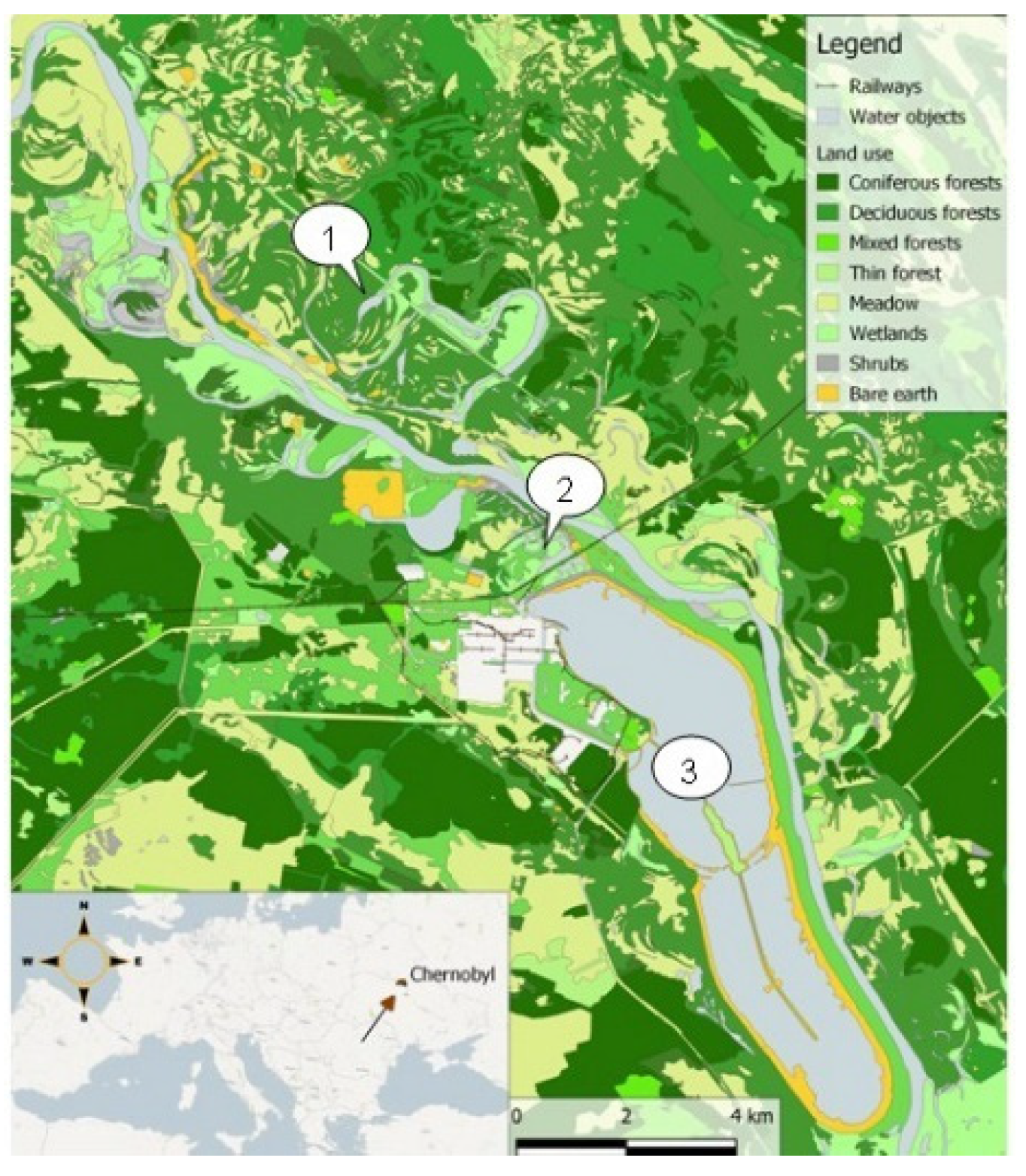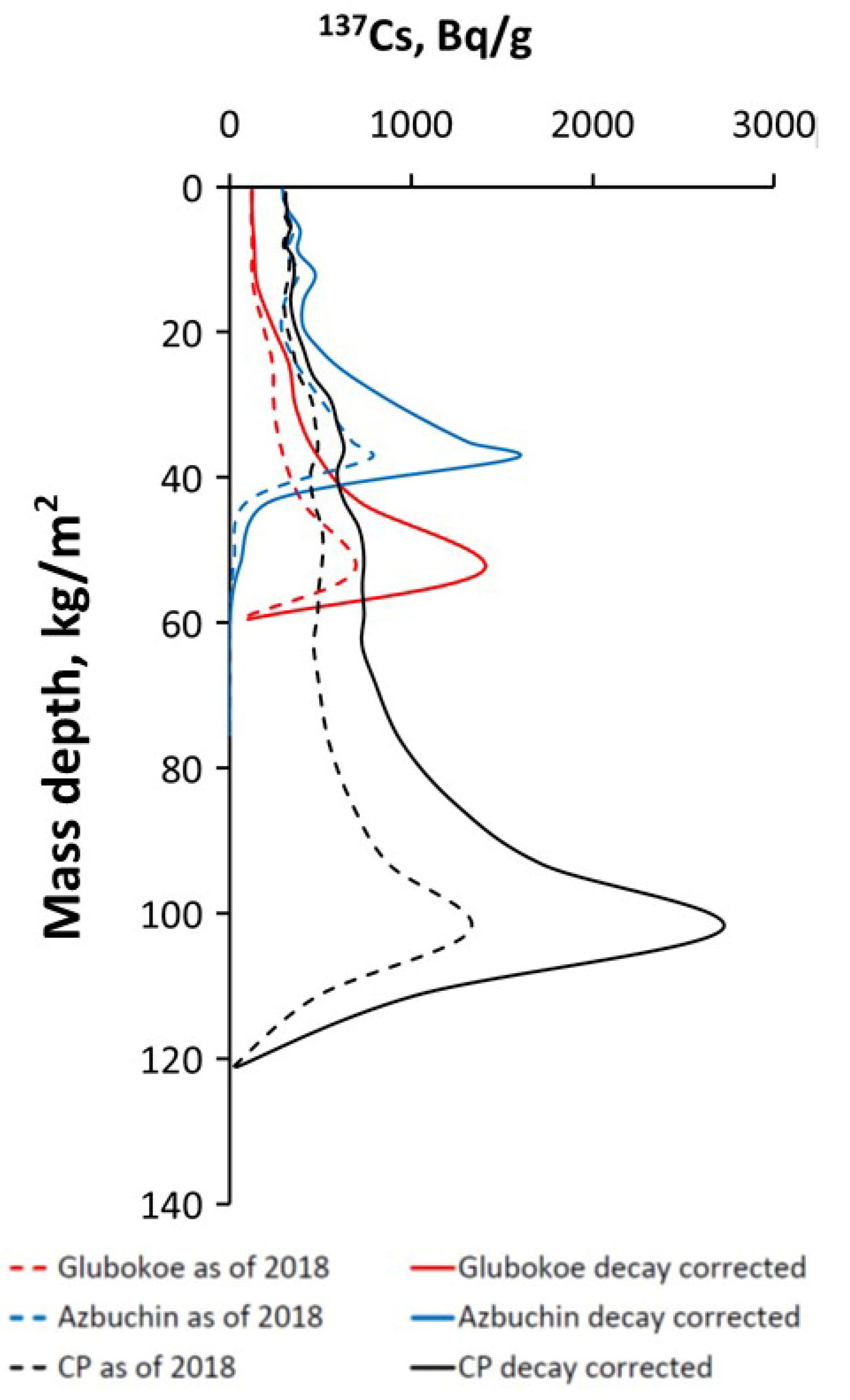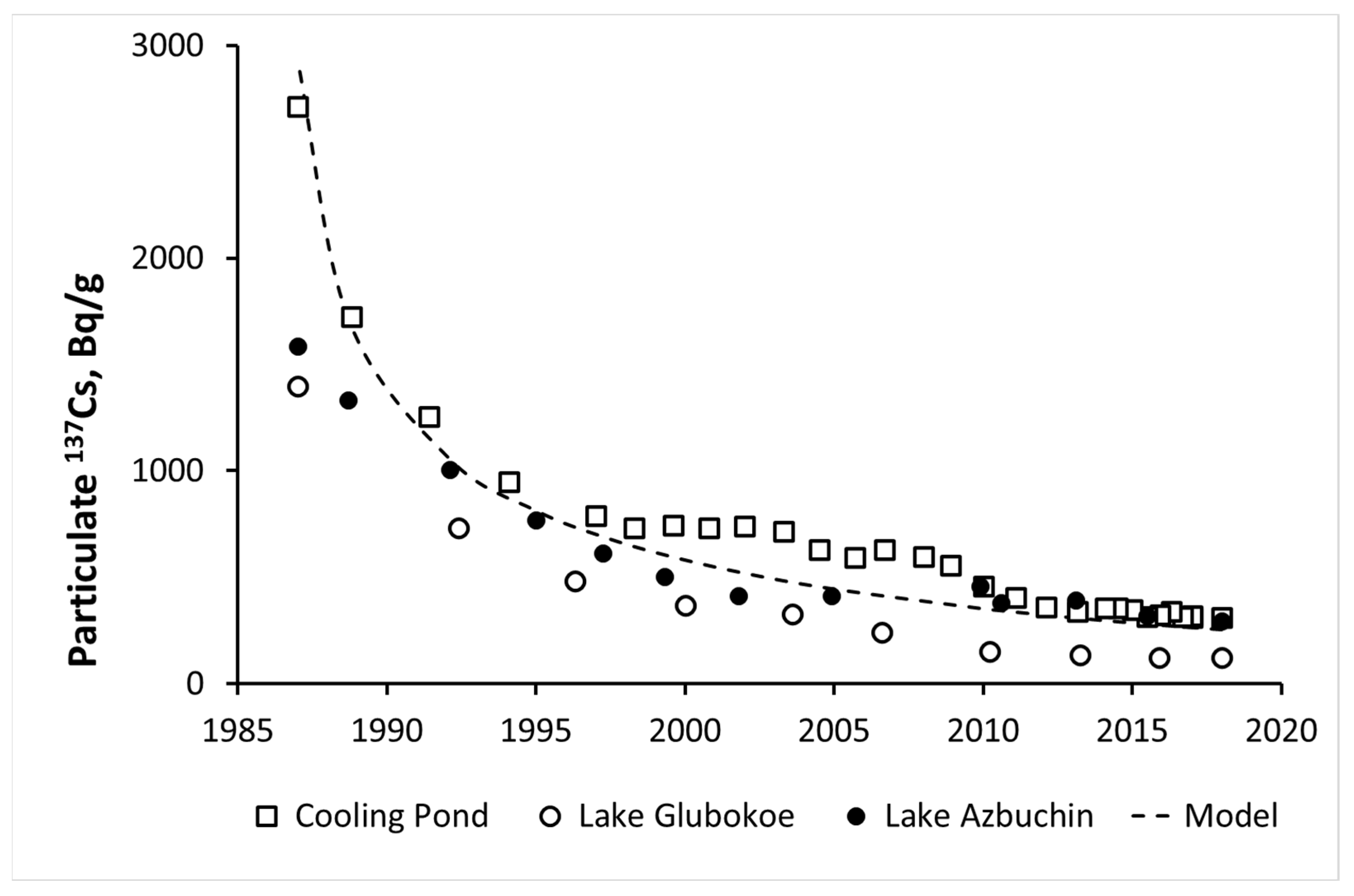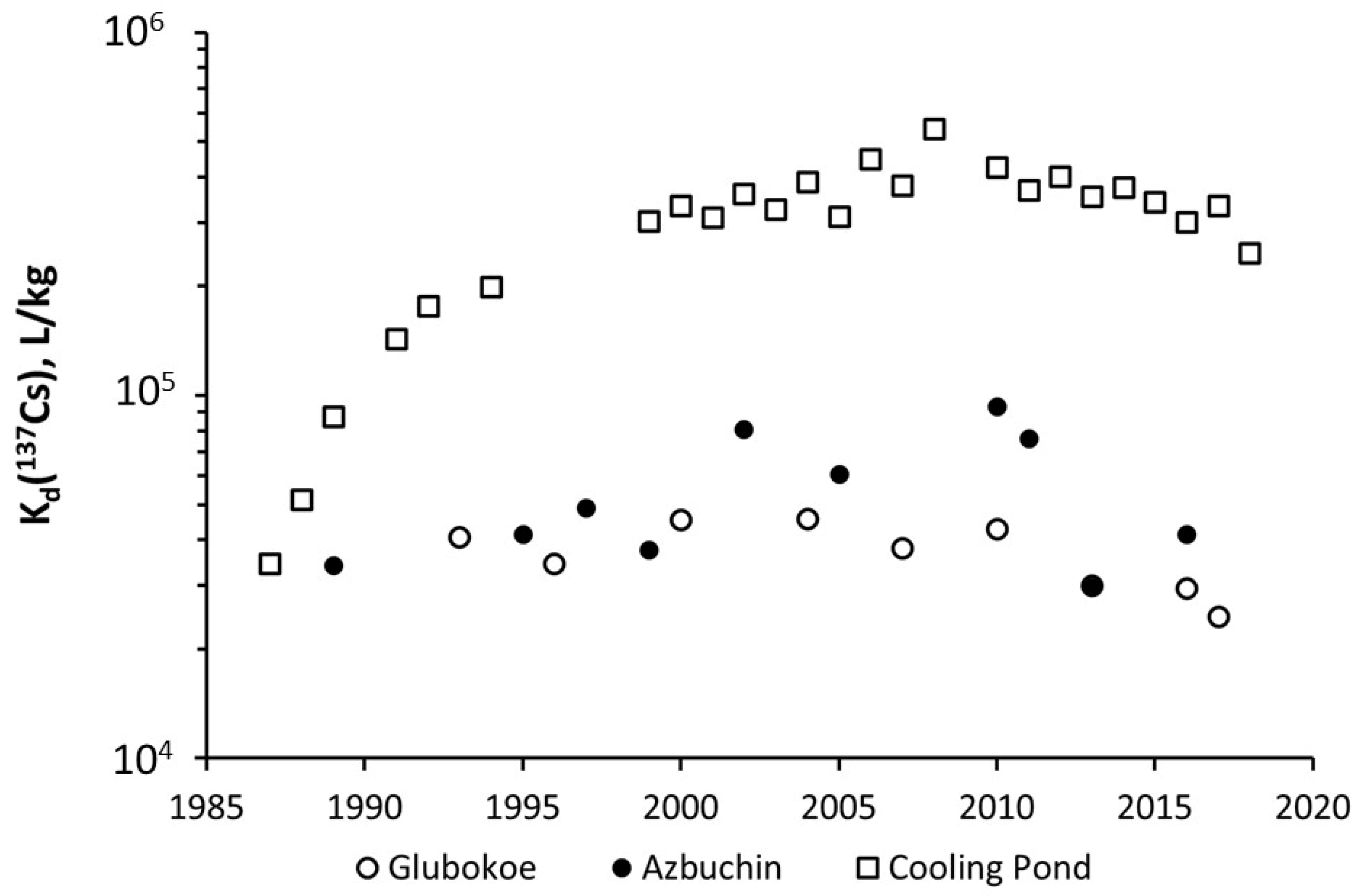Reconstruction of the Long-Term Dynamics of Particulate Concentrations and Solid–Liquid Distribution of Radiocesium in Three Severely Contaminated Water Bodies of the Chernobyl Exclusion Zone Based on Current Depth Distribution in Bottom Sediments
(This article belongs to the Section Land, Soil and Water)
Abstract
:1. Introduction
2. Materials and Methods
2.1. Study Sites
2.2. Sampling
2.3. Sample Analysis
3. Results
4. Discussion
4.1. Reconstruction of Long-Term Dynamics of Particulate 137Cs Activity Concentrations in Studied Water Bodies
4.2. Reconstruction of Long-Term Dynamics of Apparent 137Cs Distribution Coefficient Kd (137Cs) in Studied Water Bodies
5. Conclusions
Author Contributions
Funding
Institutional Review Board Statement
Informed Consent Statement
Data Availability Statement
Acknowledgments
Conflicts of Interest
References
- Comans, R.N.J.; Voitsekhovich, O.; Hilton, J.; Laptev, G.; Popov, V.; Madruga, M.J.; Bulgakov, A.; Smith, J.; Movchan, N.; Konoplev, A. A comparative study of radiocesium mobility measurements in soils and sediments from the catchment of a small, upland oligotrophic lake (Devoke Water, UK). Water Res. 1998, 32, 2846–2855. [Google Scholar] [CrossRef]
- Konoplev, A.V.; Bulgakov, A.A.; Zhirnov, V.G.; Bobovnikova, T.S.I.; Kutnyakov, I.V.; Siverina, F.A.; Popov, V.E.; Virchenko, E.P. Study of the 137Cs and 90Sr behaviour in lakes Svyatoe and Kozhanovskoe, Bryansk region. Russ. Meteorol. Hydrol. 1998, 11, 45–53. [Google Scholar]
- Bulgakov, A.A.; Konoplev, A.V.; Smith, J.T.; Hilton, J.; Comans, R.N.J.; Laptev, G.V.; Christyuk, B.F. Modelling the long-term dynamics of radiocaesium in closed lakes. J. Environ. Radioact. 2002, 61, 41–53. [Google Scholar] [CrossRef]
- Konoplev, A.V.; Kaminski, S.; Klemt, E.; Konopleva, I.; Miller, R.; Zibold, G. Comparative study of 137Cs partitioning between solid and liquid phases in Lakes Constance, Lugano and Vorsee. J. Environ. Radioact. 2002, 58, 1–11. [Google Scholar] [CrossRef]
- Smith, J.T.; Belova, N.V.; Bulgakov, A.A.; Comans, R.N.J.; Konoplev, A.V.; Kudelsky, A.V.; Madruga, M.J.; Voitsekhovich, O.V.; Zibold, G. The “AQUASCOPE” simplified model for predicting 89,90Sr, and 134,137Cs in surface waters after a large-scale radioactive fallout. Health Phys. 2005, 89, 628–644. [Google Scholar] [CrossRef]
- Wakiyama, Y.; Konoplev, A.; Wada, T.; Takase, T.; Byrnes, I.; Carradine, M.; Nanba, K. Behavior of 137Cs in ponds in the vicinity of the Fukushima Dai-ichi nuclear power plant. J. Environ. Radioact. 2017, 178–179, 367–376. [Google Scholar] [CrossRef]
- Tsukada, H.; Nihira, S.; Watanabe, T.; Takeda, S. The 137Cs activity concentration of suspended and dissolved fractions in irrigation waters collected from the 80 km zone around TEPCO’s Fukushima Daiichi Nuclear Power Station. J. Environ. Radioact. 2017, 178–179, 354–359. [Google Scholar] [CrossRef]
- Suzuki, K.; Watanabe, S.; Yusa, Y.; Yamashita, Y.; Arai, H.; Tanaka, H.; Kuge, T.; Mori, M.; Tsunoda, K.; Nohara, S.; et al. Radiocesium dynamics in the aquatic ecosystem of Lake Onuma on Mt. Akagi following the Fukushima Dai-ichi Nuclear Power Plant Accident. Sci. Total Environ. 2018, 622–623, 1153–1154. [Google Scholar] [CrossRef]
- Wada, T.; Konoplev, A.V.; Wakiyama, Y.; Watanabe, K.; Furita, Y.; Morishita, D.; Kawata, G.; Nanba, K. Strong contrast of cesium radioactivity between marine and freshwater fish in Fukushima. J. Environ. Radioact. 2019, 204, 132–142. [Google Scholar] [CrossRef]
- Konoplev, A.; Wakiyama, Y.; Wada, T.; Udy, C.; Kanivets, V.; Ivanov, V.; Komissarov, M.; Goto, A.; Nanba, K. Radiocesium distribution and mid-term dynamics in the ponds of the Fukushima Dai-ichi nuclear power plant exclusion zone. Chemosphere 2021, 265, 129058. [Google Scholar] [CrossRef]
- Strand, P.; Brown, J.E.; Drozhko, E.; Mokrov Yu Salbu, B.; Oughton, D.; Christensen, G.C.; Amundsen, I. Biogeochemical behaviour of 137Cs and 90Sr in the artificial reservoirs of Mayak PA, Russia. Sci. Total Environ. 1999, 241, 107–116. [Google Scholar] [CrossRef]
- Mokrov, Y.G.; Glagolenko, Y.V.; Drozhko, E.G.; Rovny, S.I. The Techa Reservoir cascade: Safety and regulation problems. In Challenges in Radiation Protection and Nuclear Safety Regulation in Nuclear Legacy; Sneve, M.K., Kiselev, M.F., Eds.; Springer: Berlin/Heidelberg, Germany, 2008; pp. 163–174. [Google Scholar]
- Rozhkova, A.K.; Kuzmenkova, N.V.; Pryakhin, E.A.; Mokrov, Y.G.; Kalmykov, S.N. Artificial radionuclides association with bottom sediment components from Mayak Production Association industrial reservoirs. J. Environ. Radioact. 2021, 232, 106569. [Google Scholar] [CrossRef]
- Whicker, F.W.; Pinder, J.E., III; Bowling, J.W.; Alberts, J.J.; Brisbin, A.I., Jr. Distribution of long-lived radionuclides in an abandoned reactor cooling reservoir. Ecol. Monogr. 1990, 60, 471–496. [Google Scholar] [CrossRef]
- Pinder, J.E., III; Hinton, T.G.; Whicker, F.W. Contrasting cesium dynamics in neighboring deep and shallow warm-water reservoirs. J. Environ. Radioact. 2010, 101, 659–669. [Google Scholar] [CrossRef]
- Wang, J.; Baskaran, M.; Niedermiller, J. Mobility of 137Cs in freshwater lakes: A mass balance and diffusion study of Lake St. Clair, Southeast Michigan, USA. Geochim. Cosmochim. Acta 2017, 218, 323–342. [Google Scholar] [CrossRef]
- Voitsekhovych, O.V.; Kanivets, V.V.; Kireev, S.I.; Laptev, G.V.; Obrizan, S.M. Radioactive contamination of surface waters. In 30 Years of the Chernobyl Catastrophe; KiM: Chernobyl, Ukraine, 2016; pp. 129–139. (In Ukrainian) [Google Scholar]
- Kanivets, V.; Laptev, G.; Konoplev, A.; Lisovyi, H.; Derkach, G.; Voitsekhovich, O. Distribution and dynamics of radionuclides in the Chernobyl cooling pond. In Behavior of Radionuclides in the Environment II: Chernobyl; Konoplev, A., Kato, K., Kalmykov, S.N., Eds.; Springer Nature: Singapore, 2020; pp. 349–405. [Google Scholar]
- Konoplev, A.V.; Ivanov, M.; Golosov, V.N.; Konstantinov, E.A. Reconstruction of long-term dynamics of Chernobyl-derived 137Cs in the Upa River using bottom sediments in the Schekino reservoir and semi-empirical modelling. Proc. Int. Assoc. Hydrol. Sci. 2019, 381, 95–99. [Google Scholar]
- Ivanov, M.M.; Konoplev, A.V.; Walling, D.E.; Konstantinov, E.A.; Gurinov, A.L.; Ivanova, N.N.; Kuzmenkova, N.V.; Tsyplenkov, A.S.; Ivanov, M.A.; Golosov, V.N. Using reservoir sediment deposits to reconstruct the longer-term fate of Chernobyl-derived 137Cs fallout in the fluvial system. Environ. Pollut. 2021, 274, 116588. [Google Scholar] [CrossRef]
- Konoplev, A.; Wakiyama, Y.; Wada, T.; Ivanov, M.; Komissarov, M.; Nanba, K. Reconstruction of time changes in radiocesium concentrations in the river of the Fukushima Dai-ichi NPP contaminated area based on its depth distribution in dam reservoir’s bottom sediments. Environ. Res. 2021, 112307, in press. [Google Scholar] [CrossRef]
- Vakulovsky, S.M.; Nikitin, A.I.; Chumichev, V.B.; Katrich IYu Voitsekhovich, O.V.; Medinets, V.I.; Pisarev, V.V.; Bovkun, L.A.; Khersonsky, E.S. Cesium-137 and strontium-90 contamination of water bodies in the areas affected by releases from the Chernobyl nuclear power plant accident: An overview. J. Environ. Radioact. 1994, 23, 103–122. [Google Scholar] [CrossRef]
- Konoplev, A.V.; Bulgakov, A.A.; Popov, V.E.; Popov, O.F.; Scherbak, A.V.; Shveikin, Y.V.; Hoffman, F.O. Model testing using Chernobyl data: I. Wash-off of Sr-90 and Cs-137 from two experimental plots established in the vicinity of Chernobyl reactor. Health Phys. 1996, 70, 8–12. [Google Scholar] [CrossRef]
- Garcia-Sanchez, L.; Konoplev, A.V. Watershed wash-off of atmospherically deposited radionuclides: A review of normalized entrainment coefficients. J. Environ. Radioact. 2009, 100, 774–778. [Google Scholar] [CrossRef]
- Igarashi, Y.; Onda, Y.; Wakiyama, Y.; Konoplev, A.; Zheleznyak, M.; Lisovyi, H.; Laptev, G.; Demiyanovich, V.; Samoilov, D.; Nanba, K.; et al. Impact of wildfire on 137Cs and 90Sr wash-off in heavily contaminated forests in the Chernobyl exclusion zone. Environ. Pollut. 2020, 259, 113764. [Google Scholar] [CrossRef]
- Donigian, A.S., Jr.; Beyerlein, D.C.; Davis, H.H.; Crawford, N.H. Agricultural Runoff Management (ARM) Model, Version II: Refinement and Testing; EPA 600/3-77-098; EPA: Athens, GA, USA, 1977.
- Knisel, W.G. (Ed.) CREAMS: A Field-Scale Model for Chemicals Runoff, and Erosion from Agricultural Management Systems; USDA Conservation Research Report No. 26; Department of Agriculture, Science and Education Administration: Washington, DC, USA, 1980; 643p.
- Ahuja, L.R.; Sharpley, A.N.; Yamamoto, M.; Menzel, R.G. The depth of rainfall-runoff-soil interaction as determined by 32P. Water Res. 1981, 17, 969–974. [Google Scholar] [CrossRef]
- Borzilov, V.A.; Sedunov, Y.U.S.; Novitskii, M.A.; Vozzhennikov, O.I.; Konoplev, A.V.; Dragolyubova, I.V. Physico-mathematical modeling of washout of long-lived radionuclides from drainage basins in the 30-km zone around the Chernobyl Nuclear Power Station. Sov. Meteorol. Hydrol. 1989, 1, 1–8. Available online: https://publons.com/publon/21056541/ (accessed on 25 October 2021).
- Bulgakov, A.A.; Konoplev, A.V.; Popov, V.E.; Scherbak, A.V. Removal of long-lived radionuclides from soil by surface runoff near the Chernobyl nuclear power station. Sov. Soil Sci. 1991, 23, 124–131. [Google Scholar]
- Vozzhennikov, O.I.; Vasil’eva, K.I. Empirical principal of long-term prediction of radioactive contamination of water bodies. Radiat. Prot. Dosim. 1996, 64, 33–35. [Google Scholar] [CrossRef]
- Bulgakov, A.A.; Konoplev, A.V.; Shkuratova, I.G. Distribution of 137Cs in the topmost soil layer within a 30-km zone around the Chernobyl nuclear power plant. Pochvovedenie 2000, 9, 1149–1152. (In Russian) [Google Scholar]
- Bulgakov, A.A.; Konoplev, A.V.; Popov, V.E.; Bobovnikova, T.S.I.; Siverina, A.A.; Shkuratova, I.G. Mechanisms of vertical migration of long-lived radionuclides in soils within 30 kilometers of the Chernobyl nuclear power station. Sov. Soil Sci. 1991, 23, 46–51. [Google Scholar]
- Bossew, P.; Kirchner, G. Modelling the vertical distribution of radionuclides in soil. Part 1: The convection-dispersion equation revisited. J. Environ. Radioact. 2004, 73, 127–150. [Google Scholar] [CrossRef]
- Shaw, G.; Venter, A.; Avila, R.; Bergman, R.; Bulgakov, A.; Calmon, P.; Fesenko, S.; Frissel, M.; Goor, F.; Konoplev, A.; et al. Radionuclide migration in forest ecosystems—Results of a model validation study. J. Environ. Radioact. 2005, 84, 285–296. [Google Scholar] [CrossRef]
- Konoplev, A.V.; Golosov, V.N.; Yoschenko, V.I.; Nanba, K.; Onda, Y.; Takase, T.; Wakiyama, Y. Vertical distribution of radiocesium in soils of the area affected by the Fukushima Dai-ichi nuclear power plant accident. Eurasian Soil Sci. 2016, 49, 570–580. [Google Scholar] [CrossRef]
- Handbook of Parameter Values for the Prediction of Radionuclide Transfer in Terrestrial and Freshwater Environments; IAEA Technical Reports Series No. 472; IAEA: Vienna, Austria, 2010; 194p.
- Konoplev, A.V. Distribution of radiocesium of accidental origin between the suspended matter and solution in rivers: Comparison of Fukushima and Chernobyl. Radiochemistry 2015, 57, 552–556. [Google Scholar] [CrossRef]
- Krylov, A.L.; Nosov, A.V.; Kiselev, V. Analysis of accumulation factor of Cesium 137 in bottom sediments of surface water bodies. Russ. Meteorol. Hydrol. 2011, 36, 33–39. [Google Scholar] [CrossRef]
- Kaminski, S.; Konoplev, A.; Lindner, G.; Schroeder, H.G. The fate of artificial caesium radionuclides in Lake Constance. Arch. Hydrobiol. Spec. Issues Advanc. Limnol. 1998, 53, 369–409. [Google Scholar]
- Michel, H.; Barci-Funel, G.; Dalmasso, J.; Ardisson, G.; Appleby, P.G.; Haworth, E.; El-Daoushy, F. Plutonium, americium and cesium records in sediment cores from Blelham Tarn, Cumbria (UK). J. Radioanal. Nucl. Chem. 2001, 247, 107–110. [Google Scholar] [CrossRef]
- Appleby, P.G.; Haworth, E.Y.; Michel, H.; Short, D.B.; Laptev, G.; Piliposian, G.T. The transport and mass balance of fallout radionuclides in Blelham Tarn, Cumbria (UK). J. Paleolimn. 2003, 29, 459–473. [Google Scholar] [CrossRef]
- Nehyba, S.; Nyvit, D.; Schkade, U.; Kirchner, G.; Francu, E. Deposition rates and dating techniques of modern deposits in the Brno reservoir (Czech Republic) during the last 70 years. J. Paleolimnol. 2011, 45, 41–55. [Google Scholar] [CrossRef]
- Konoplev, A.; Kanivets, V.; Laptev, G.; Voitsekhovich, O.; Zhukova, O.; Germenchuk, M. Long-term dynamics of the Chernobyl-derived radionuclides in rivers and lakes. In Behavior of Radionuclides in the Environment II: Chernobyl; Konoplev, A., Kato, K., Kalmykov, S.N., Eds.; Springer Nature: Singapore, 2020; pp. 323–348. [Google Scholar]
- Konoplev, A.; Kanivets, V.; Zhukova, O.; Germenchuk, M.; Derkach, G. Mid- to long-term radiocesium wash-off from contaminated catchments at Chernobyl and Fukushima. Water Res. 2021, 188, 116514. [Google Scholar] [CrossRef]
- Ganzha Ch Gudkov, D.; Ganzha, D.; Klenus, V.; Nazarov, A. Physicochemical forms of 90Sr and 137Cs in components of Gluboke lake ecosystem in the Chernobyl exclusion zone. J. Environ. Radiaoact. 2014, 127, 176–181. [Google Scholar] [CrossRef]
- Kuzmenko, M.I. (Ed.) Radionuclides in Aquatic Ecosystems of Ukraine. Influence of Radioactive Contamination on Hydrobionts of the Exclusion Zone; Chernobylinterinform: Kiev, Ukraine, 2001; 318p. (In Ukrainian) [Google Scholar]
- Makhon’ko, K.P. (Ed.) Guidance on Monitoring of the Environment around NPP Sites; Gidrometeoizdat: Leningrad, Russia, 1990; 264p. (In Russian) [Google Scholar]
- Remez, V.P.; Zheltonozhko, E.V.; Sapozhnikov, Y.A. Experience of using ANFEZH sorbent for recovery of radioactive caesium from sea water. Radiat. Prot. Dosim. 1998, 75, 77–78. [Google Scholar] [CrossRef]
- Remez, V.P.; Semenishchev, V.S.; Voronina, A.V.; Ioshin, A.A. The Sorbent-Tec system for rapid dosimetric evaluation of 137Cs in drinking water. J. Radioanal. Nucl. Chem. 2016, 311, 135–140. [Google Scholar] [CrossRef]
- Gilmore, G. Practical Gamma-Ray Spectroscopy, 2nd ed.; John Wiley & Sons: Hoboken, NJ, USA, 2016; p. 408. [Google Scholar]
- Appleby, P.G.; Richardson, N.; Nolan, P.J. Self-absorption corrections for well-type germanium detectors. Nucl. Inst. Methods B 1992, 71, 228–233. [Google Scholar] [CrossRef]
- Sansone, U.; Belli, M.; Voitsekhovich, O.V.; Kanivets, V.V. 137Cs and 90Sr in water and suspended particulate matter of the Dnieper River-Reservoirs System (Ukraine). Sci. Total Environ. 1996, 186, 257–271. [Google Scholar] [CrossRef]
- Ivanov, Y.A.; Lewyckyj, N.; Levchuk, S.E.; Prister, B.S.; Firsakova, S.K.; Arkhipov, N.P.; Kruglov, S.V.; Alexakhin, R.M.; Sandalls, J.; Askbrant, S. Migration of 137Cs and 90Sr from Chernobyl fallout in Ukrainian, Belarussian and Russian soils. J. Environ. Radioact. 1997, 35, 1–21. [Google Scholar] [CrossRef]
- Bulgakov, A.; Konoplev, A.; Smith, J.; Laptev, G.; Voitsekhovich, O. Fuel particles in the Chernobyl cooling pond: Current state and prediction for remediation options. J. Environ. Radioact. 2009, 100, 329–332. [Google Scholar] [CrossRef]
- Kashparov, V.; Salbu, B.; Simonucci, C.; Levchuk, S.; Reinoso-Maset, E.; Lind, O.C.; Maloshtan, I.; Protsak, V.; Courbet, C.; Nguyen, H. Validation of a fuel particle dissolution model with samples from the Red Forest within the Chernobyl exclusion zone. J. Environ. Radioact. 2020, 223–224, 106387. [Google Scholar] [CrossRef] [PubMed]
- Putyrskaya, V.; Klemt, E.; Roellin, S.; Corcho-Alvarado, J.A.; Sahli, H. Dating of recent sediments from Lago Maggiore and lagodi Lugano (Switzerland/Italy) using 137Cs and 210Pb. J. Environ. Radioact. 2020, 212, 106135. [Google Scholar] [CrossRef]
- Wischmeier, W.H.; Smith, D.D. Predicting Rainfall Erosion Losses. A Guide to Conservation Planning; The USDA Agricultural Handbook No. 537; Department of Agriculture, Science and Education Administration: Washington, DC, USA, 1978.






| Water Body | Lake Glubokoe | Lake Azbuchin | Cooling Pond |
|---|---|---|---|
| Coordinates | 51.444° N 30.065° E | 51.406° N 30.117° E | 51.354° N 30.166° E |
| 137Cs mean deposition, MBq/m2 | 11 ± 5 a | 7.6 ± 3.2 a | 4.2 ± 1.3 b |
| Water surface area, km2 | 0.17 | 0.23 | 22.6 |
| Maximum depth, m | 7.1 | 5.5 | 17.0 |
| Average depth, m | 3.0 | 2.5 | 6.2 |
| Reference | [46] | [47] | [18] |
| Water Body | Lake Glubokoe | Lake Azbuchin | Cooling Pond |
|---|---|---|---|
| Sampling date | 25.07.2018 | 24.07.2018 | 05.06.2018 |
| Sampling location coordinates | N51.34583 E30.16242 | N51.4057 E30.1119 | N51.3458 E30.1624 |
| Depth at sampling location, m | 6.3 | 4.2 | 8.6 |
| Core length, cm | 41 | 62 | 68 |
| Mean sedimentation rate a, kg/m2y (cm/y) | 1.65 (1.1) | 1.2 (1.4) | 3.2 (1.7) |
| 137Cs inventory b, MBq/m2 | 18 ± 3.6 | 17 ± 3.4 | 63 ± 12 |
| 241Am inventory b, MBq/m2 | 0.8 ± 0.16 | 0.5 ± 0.1 | 1.7 ± 0.35 |
Publisher’s Note: MDPI stays neutral with regard to jurisdictional claims in published maps and institutional affiliations. |
© 2021 by the authors. Licensee MDPI, Basel, Switzerland. This article is an open access article distributed under the terms and conditions of the Creative Commons Attribution (CC BY) license (https://creativecommons.org/licenses/by/4.0/).
Share and Cite
Konoplev, A.; Laptev, G.; Igarashi, Y.; Derkach, H.; Protsak, V.; Lisovyi, H.; Korychenskyi, K.; Kirieiev, S.; Samoilov, D.; Nanba, K. Reconstruction of the Long-Term Dynamics of Particulate Concentrations and Solid–Liquid Distribution of Radiocesium in Three Severely Contaminated Water Bodies of the Chernobyl Exclusion Zone Based on Current Depth Distribution in Bottom Sediments. Land 2022, 11, 29. https://doi.org/10.3390/land11010029
Konoplev A, Laptev G, Igarashi Y, Derkach H, Protsak V, Lisovyi H, Korychenskyi K, Kirieiev S, Samoilov D, Nanba K. Reconstruction of the Long-Term Dynamics of Particulate Concentrations and Solid–Liquid Distribution of Radiocesium in Three Severely Contaminated Water Bodies of the Chernobyl Exclusion Zone Based on Current Depth Distribution in Bottom Sediments. Land. 2022; 11(1):29. https://doi.org/10.3390/land11010029
Chicago/Turabian StyleKonoplev, Alexei, Gennady Laptev, Yasunori Igarashi, Hrigoryi Derkach, Valentin Protsak, Hlib Lisovyi, Kyrylo Korychenskyi, Serhii Kirieiev, Dmitry Samoilov, and Kenji Nanba. 2022. "Reconstruction of the Long-Term Dynamics of Particulate Concentrations and Solid–Liquid Distribution of Radiocesium in Three Severely Contaminated Water Bodies of the Chernobyl Exclusion Zone Based on Current Depth Distribution in Bottom Sediments" Land 11, no. 1: 29. https://doi.org/10.3390/land11010029
APA StyleKonoplev, A., Laptev, G., Igarashi, Y., Derkach, H., Protsak, V., Lisovyi, H., Korychenskyi, K., Kirieiev, S., Samoilov, D., & Nanba, K. (2022). Reconstruction of the Long-Term Dynamics of Particulate Concentrations and Solid–Liquid Distribution of Radiocesium in Three Severely Contaminated Water Bodies of the Chernobyl Exclusion Zone Based on Current Depth Distribution in Bottom Sediments. Land, 11(1), 29. https://doi.org/10.3390/land11010029









